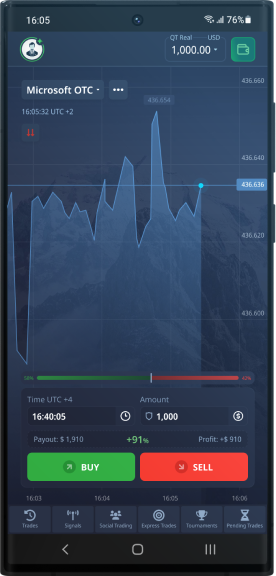
In the ever-evolving world of online trading, becoming a successful Pocket Option Trader Pocket Option trader requires a combination of strategy, discipline, and the right tools. Trading binary options has gained popularity over the years, allowing traders to speculate on price movements in various financial instruments. With a user-friendly interface and diverse trading options, Pocket Option offers an appealing platform for both new and experienced traders. In this article, we will dive into the essential aspects of becoming a successful Pocket Option trader, examining valuable strategies, resources, and tips that can elevate your trading experience.
Understanding Pocket Option
Pocket Option is a brokerage that provides traders with a platform to engage in binary options trading. Established in 2017, it has quickly gained traction due to its intuitive interface, advanced trading features, and the allure of high returns. What sets Pocket Option apart is its focus on user experience, offering a range of tools and resources designed to facilitate effective trading. Whether you are a novice exploring the fundamentals or an experienced trader seeking to refine your strategies, Pocket Option is equipped to meet your needs.
Getting Started with Pocket Option
To begin your journey as a Pocket Option trader, the first step is to create an account. The registration process is straightforward, requiring basic identification information. Once registered, you can access a demo account to practice your trading skills without risking real money. This feature is invaluable for honing your strategies and gaining confidence before transitioning to a live account.
Demo Account: A Crucial Tool for Beginners
The demo account available on Pocket Option allows you to trade with virtual funds, providing an excellent opportunity to familiarize yourself with the platform and trading mechanics. Take advantage of this feature to test different strategies, analyze market movements, and develop your trading style. Remember, the goal during this phase is to learn and gain experience rather than to make profits.
Key Strategies for Successful Trading
As you gain confidence and familiarity with the Pocket Option platform, developing a solid trading strategy becomes paramount. Here are some effective strategies you can implement:
1. Trend Following
One of the most popular trading strategies is trend following. This method involves analyzing market trends—either bullish (upward) or bearish (downward)—and making trades that align with these movements. By identifying the overall direction of the market, traders can increase their chances of success and minimize risks.
2. Support and Resistance Levels
Understanding support and resistance levels is crucial for any trader. Support levels indicate where prices tend to stop falling and bounce back up, while resistance levels are points where prices struggle to rise further. By identifying these levels, Pocket Option traders can make informed decisions on when to enter or exit trades.
3. News Trading
Staying informed about current events, economic indicators, and market news can provide valuable insights for your trading decisions. News trading involves making trades based on how news announcements might affect market prices. Pocket Option traders who can quickly analyze news reports and identify potential market impacts can benefit from significant price movements.
Risk Management: Protecting Your Capital

Effective risk management is crucial for long-term success as a Pocket Option trader. Here are key principles to consider:
1. Set a Budget
Before trading, determine a budget that you can afford to lose. This amount should not impact your financial stability. Stick to this budget rigorously and avoid emotional trading—where you make decisions based on feelings rather than logic.
2. Use Stop Losses
Incorporate stop-loss orders into your trading plan. These orders automatically close your positions at set price levels, limiting your potential losses. This tool is essential for minimizing risk and protecting your capital.
3. Diversification
Avoid putting all your eggs in one basket. Diversifying your trades across different assets can help reduce risk and enhance your overall portfolio performance. This way, even if one trade doesn’t go as planned, your other trades may compensate for the losses.
Utilizing Pocket Option Tools and Resources
Pocket Option provides various tools and resources to enhance your trading experience. Utilize its educational materials, including webinars, tutorials, and trading indicators. Familiarizing yourself with these tools can provide you with a better understanding of market trends, analysis techniques, and trading strategies.
1. Trading Signals
Consider using trading signals provided by experienced traders or algorithms. These signals can alert you to potential trade opportunities based on specific indicators and analyses. However, be sure to evaluate and combine these signals with your own research and strategy rather than relying solely on them.
2. Economic Calendar
Integrate an economic calendar into your trading routine. This calendar highlights key economic events and data releases, allowing you to anticipate potential market movements. By being aware of upcoming announcements, you can adjust your trading strategies accordingly.
Continuous Learning and Adaptation
The financial markets are dynamic, and strategies that may work today might not be as effective tomorrow. Therefore, continuous learning and adaptation are vital. Follow financial news, engage with other traders through forums and social media, and consider joining educational courses to continually improve your trading skills.
Conclusion
Becoming a successful Pocket Option trader is a journey that involves understanding the market, strategizing, managing risks, and continuously learning. By following the strategies outlined in this article, leveraging the resources available, and maintaining discipline, you can enhance your trading experience and work towards achieving your financial goals. Remember, trading is not merely about winning; it’s about developing your skills, understanding the market landscape, and becoming a resilient trader.